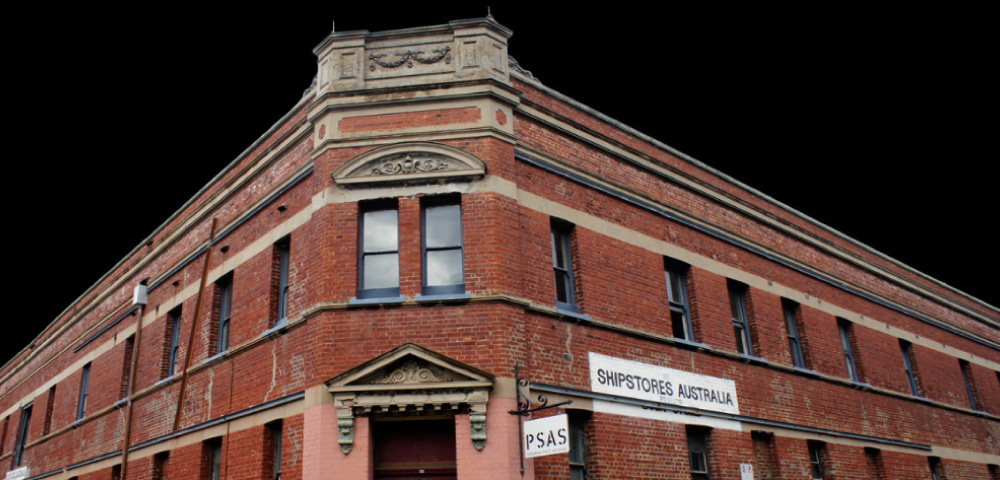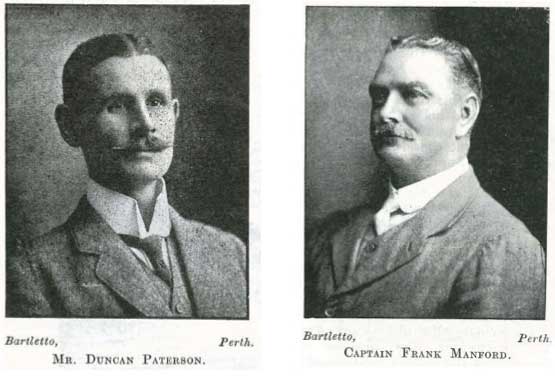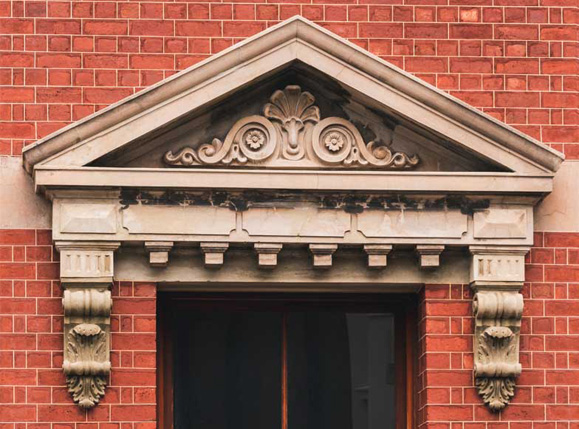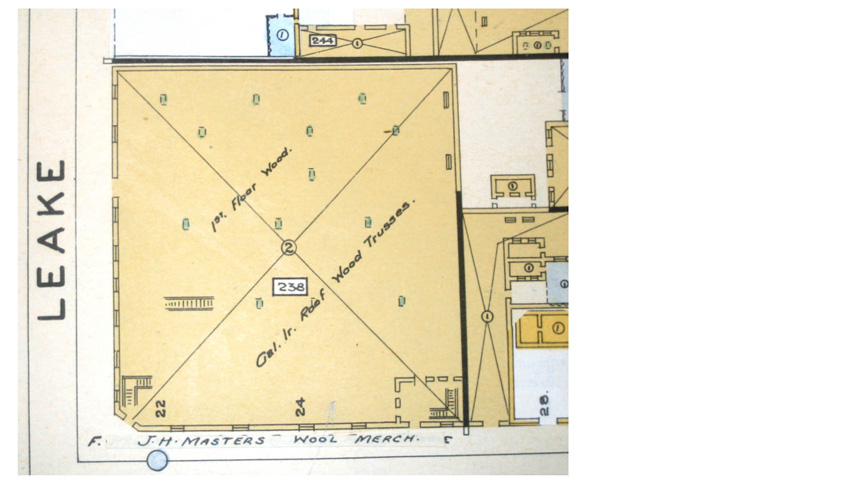The Building

The two storey brick and iron building occupies the entire lot and was constructed in 1907 for owner Timothy Francis Quinlan. Quinlan was a significant property owner and business man in Perth during the early 20th century. The first occupants of the warehouse were Paterson and Co, a business which stored and sold a wide range of goods. The building has most frequently been used for storage since its construction, however for a considerable period it was a depot for transport company, Frank Manford and Company. The form of the building has not changed markedly since its original construction and is currently used for artist’s studios.
Statement of Significance
Warehouse (fmr) 22-26 Pakenham St, a two storey brick and iron industrial building in the Federation warehouse style built in 1907 for owner Timothy Quinlan, has cultural heritage significance for the following reasons:The place is a good representation of the Federation Warehouse style. Its external brick walls; saw tooth roof form and repetition of elements are classic features of the style. Its scale and form make a valuable contribution to the streetscape and the heritage precinct of the West End of Fremantle;
The place is rare as one of the most intact examples of a building of the 1900s remaining in the West End of Fremantle and demonstrates both the character and the uses, which represent this section of the West End of Fremantle. It has been largely unmodified since its original construction and demonstrates the simple form and finishes of early 20th century warehouses. The remaining fabric and machinery also provides evidence of former practices; Warehouse (fmr) 22-26 Pakenham St demonstrates the development of the Fremantle Port as a major centre for trade and commerce. Its location demonstrates how the relocation of the harbour and the construction of the Fremantle Railway Station resulted in the creation of a new focus for the town of Fremantle;
The place is a good example of key industries, which have helped to shape Fremantle and the wider economy of Western Australia. Its association with the wool industry, bonded stores and transport are good examples of the types of goods and services associated with Fremantle;
Heritage and Conservation
The two storey brick and iron building occupies the entire lot and was constructed in 1907 for owner Timothy Francis Quinlan. Quinlan was a significant property owner and business man in Perth during the early 20th century. The first occupants of the warehouse were Paterson and Co, a business which stored and sold a wide range of goods. The building has most frequently been used for storage since its construction, however for a considerable period it was a depot for transport company, Frank Manford and Company. The place is a good representation of the Federation Warehouse style. Its external brick walls; saw tooth roof form and repetition of elements are classic features of the style. Its scale and form make a valuable contribution to the streetscape and the heritage precinct of the West End of Fremantle.

The place is rare as one of the most intact examples of a building of the 1900s remaining in the West End of Fremantle and demonstrates both the character and the uses, which represent this section of the West End of Fremantle. It has been largely unmodified since its original construction and demonstrates the simple form and finishes of early 20th century warehouses. The remaining fabric and machinery also provides evidence of former practices and demonstrates the development of the Fremantle Port as a major centre for trade and commerce. Its location demonstrates how the relocation of the harbour and the construction of the Fremantle Railway Station resulted in the creation of a new focus for the town of Fremantle. The place is also a good example of key industries, which have helped to shape Fremantle and the wider economy of Western Australia. Its association with the wool industry, bonded stores and transport are good examples of the types of goods and services associated with Fremantle.

The building is currently managed by PS Art Space, a progressive, contemporary exhibition and performance space, creative studios, and venue for functions. The site has been fortunate to find itself the subject of an ongoing conservation program, following completion of a grant-assisted conservation management plan in 2010. The conservation management incorporated a structural’s engineer’s report to assist in identifying defects and to ensure these were remedied according to priority, in line with best practice from both engineering and heritage conservation standards.
Previous projects were undertaken to repair structural degradation to the exterior and interior and restore the original exterior appearance by removing intrusive paint and mortar and reinstating original elements. This year’s grant-assisted project saw continued conservation of the building a section to the entrance threshold and a geotechnical investigation to identify any underlying site issues, which will help inform the planning of future conservation works and monitoring of potential issues.
The continued conservation of the building demonstrates an exemplary commitment to heritage conservation by the owner. By employing the services of experienced heritage professionals, the owner has ensured that the building is conserved according to best practice, enhancing the longevity of the building elements, improving the overall condition of the building and conservation works in future.

References:
Register entry Heritage Council State Heritage Office
Pakenham St Fremantle Stuff, West End
Download current floor plan
TIMELINE
1829 Establishment of the town of Fremantle
1850-1868 Transportation of convicts
1881 Opening of the Fremantle to Guildford Railway Line
1893 Establishment of the Fremantle Municipal Council
1897 Fremantle Harbour Opened
1890s Gold boom period
1902 Timothy Francis Quinlan purchases Fremantle Town Lots 407 and 408
1907 Warehouse (fmr) 22-26 Pakenham St constructed
1907-1908 Patrick O'Connell
1907 Opening of the Fremantle Railway Station
1908-1918 Paterson & Co.
1918-1920 Elder Smith & Co.
1929 Fremantle proclaimed a city
1930-1960 Manford & Co.
1960-1964 Wool Exporters Pty. Ltd.
1964-1968 Oversseas Wool Trading Co. Pty. Ltd.
1968-1972 B.M. Bahen Pty. Ltd.
1972-1974 Premier Wools (WA) Pty. Ltd.
1974 Opening of the Stirling Traffic Bridge
1974-1975 T.T. Dyson & Co.
1975-1993 WA Ship Supplies & Shipstores Australia Pty. Ltd.
1994-1997 Allegretta artist studios
1997-199 Property transferred to Portshine Pty Ltd. (Helene Schairer and James Paris), PS Art Studios and Gallery
2007 Conservation Report produced through a State Heritage grant
2012 Founding of PSAS (Helene Schairer with artist Tom Mùller)
2014 Concrete slab poured on ground floor
2015 First heritage council grant for reinstatement of sash windows
2017 Facade conservation works through second heritage council grant
2019 Third heritage grant to reinforce internal structural bracing
